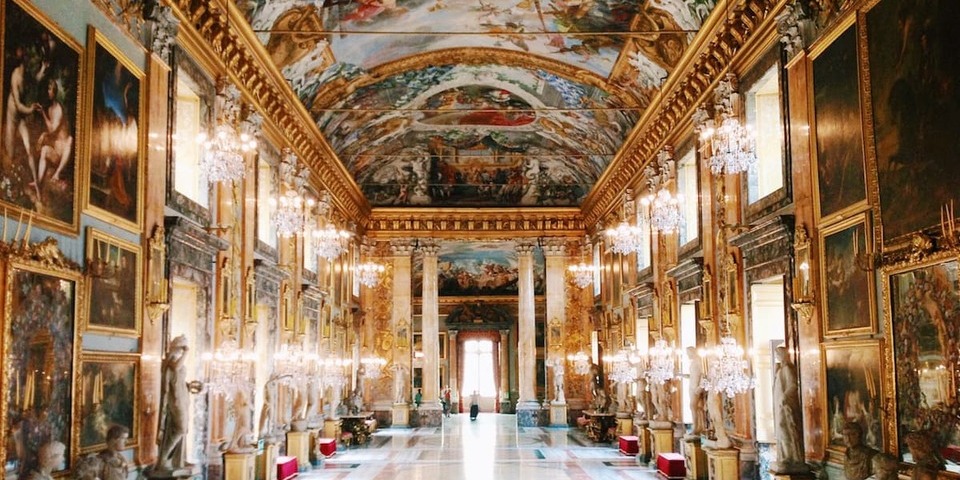

24786 views

| Tickets |
Buy tickets online: |
|---|---|
| Tip | For the more curious, guided tours are available on Fridays. You can only visit with an official guide. Tours are in Italian at 9:30, 10:00, and 10:30, in English at 10:00, and in French at 10:30. Be sure to book your tour several weeks in advance to secure your spot. Independent visits are possible on Saturdays. |
| Opening Hours |
Saturday:
-
|
| Recommended tour | |
| Closest bus stops |
|
| Closest subway stations |
|
| Address | Via della Pilotta, 17, Roma |
| Website | www.galleriacolonna.it |
The Colonna Palace Gallery in Rome is a renowned art museum celebrated for its exceptional collection of Baroque and Renaissance masterpieces. Housed within the Palazzo Colonna, the gallery mesmerizes visitors with its splendid paintings, sculptures, and decorative arts, offering an immersive journey through Italy’s rich artistic heritage. From majestic frescoes to intricate sculptures, the Colonna Gallery captivates art enthusiasts with its unparalleled display of historical and cultural treasures.
Contents
ToggleThe history of the Colonna Gallery in Rome dates back to the 17th century when the Palazzo Colonna, a grand aristocratic residence, became the home of the Colonna family. As avid art collectors and patrons, the Colonna family gradually amassed a remarkable collection of paintings, sculptures, antiquities, and decorative arts.
The gallery within the Palazzo was created to showcase these treasures, and over the centuries, it grew in significance, attracting artists, scholars, and art enthusiasts.
The Palazzo and its gallery played a prominent role in Roman cultural life, hosting social gatherings, artistic discussions, and visits from notable figures like Michelangelo and Caravaggio. The family’s extensive collection expanded through generations as they acquired works by renowned artists such as Guido Reni, Tintoretto, and Lorenzo Lotto.
The gallery underwent renovations and expansions, adapting to changing tastes and preservation needs. Despite political upheavals and changing ownership dynamics in Italy, the Colonna family managed to preserve their ancestral home and its art collection, showcasing a continuous link to the city’s artistic and historical legacy.
Today, the Colonna Gallery remains a testament to the family’s passion for art and their dedication to preserving cultural heritage. It stands as a remarkable repository of Baroque and Renaissance masterpieces, offering visitors a captivating glimpse into the art and history of Rome.
Read also: Borghese Gallery and Museum
The Colonna Gallery in Rome houses a remarkable collection of artworks, and while it’s challenging to narrow it down to just five, here are some of the most famous and noteworthy pieces you shouldn’t miss:
The “Annunciation” fresco is one of the gallery’s most iconic works. Melozzo da Forlì’s masterpiece depicts the angel Gabriel announcing the Virgin Mary’s impending conception of Jesus. The fresco’s intricate details and elegant composition showcase the artist’s skill in capturing religious themes.
“St. John the Baptist” by the Venetian master Titian portrays St. John the Baptist in a contemplative pose. The use of light and shadow, along with the meticulous rendering of the figure, exemplifies Titian’s mastery of the High Renaissance style.
The “Portrait of Cardinal Agostino” marble sculpture captures the likeness of Cardinal Agostino Colonna, a prominent member of the Colonna family. Bernini’s expert craftsmanship is evident in the lifelike representation of the subject’s facial features and the delicate drapery of the cardinal’s robe.
“Martyrdom of St. Sebastian” is a remarkable work by Bernini. This sculpture portrays the moment of St. Sebastian’s martyrdom. The intensity of emotion conveyed through the saint’s expression and the dynamic composition make this piece a standout example of Baroque artistry.
The “The Assumption of the Virgin” is a large-scale painting that captures the moment the Virgin Mary ascends to heaven. Guido Reni’s graceful figures and vibrant colors create a sense of celestial movement and spirituality, making this work a prime example of the Baroque style.
These artworks, among others in the gallery, offer a glimpse into the mastery of various artistic periods and showcase the range of talent in the Colonna Gallery’s collection. Remember that the collection may be subject to changes due to exhibitions or restoration projects. So, it’s a good idea to check the gallery’s official website or consult on-site staff for the most up-to-date information before your visit.
Read about the Colonna District in Rome.
Indeed, here are some interesting facts about the Colonna Gallery:
These facts contribute to the Colonna Gallery’s reputation as a hidden gem in Rome, offering visitors a glimpse into the artistic and historical legacy of one of Italy’s noble families.
Author: Kate Zusmann
This website uses cookies. For more info read the cookies policy
Rome.us © 2025. Created with love by Roman experts and guides.